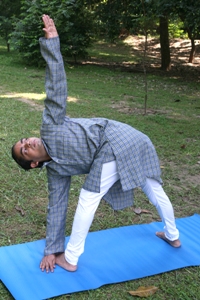Trikonasana
 This asana helps to remove tiredness by stimulating the circulation and toning the spinal nerves. It stretches massage the visceral organs. This is an excellent pre- pranayama practice as it opens up all the alveoli and helps drainage of stagnant mucus. It has the added benefits of inverted asana, especially on the brain.
This asana helps to remove tiredness by stimulating the circulation and toning the spinal nerves. It stretches massage the visceral organs. This is an excellent pre- pranayama practice as it opens up all the alveoli and helps drainage of stagnant mucus. It has the added benefits of inverted asana, especially on the brain.
It is usually performed in two parts, facing left, and then facing right. The practitioner begins standing with the feet one leg-length apart, knees unbent, turns the right foot completely to the outside and the left foot less than 45 degrees to the inside, keeping the heels in line with the hips. The arms are spread out to the sides, parallel to the ground, palms facing down; the trunk is extended as far as is comfortable to the right, while the arms remain parallel to the floor.
Once the trunk is fully extended to the right, the right arm is dropped so that the right hand reaches the shin (or a block or on the floor) to the front (left side) of the right foot, with the palm down if flexed. Note that in Utthita Trikonasana (Extended Triangle Pose) the hand is placed on the floor to the back (right side) of the right foot. The left arm is extended vertically, and the spine and trunk are gently twisted counterclockwise (i.e. upwards to the left, since they're roughly parallel to the floor), using the extended arms as a lever, while the spine remains parallel to the ground. The arms are stretched away from one another, and the head is often turned to gaze at the left thumb, slightly intensifying the spinal twist.